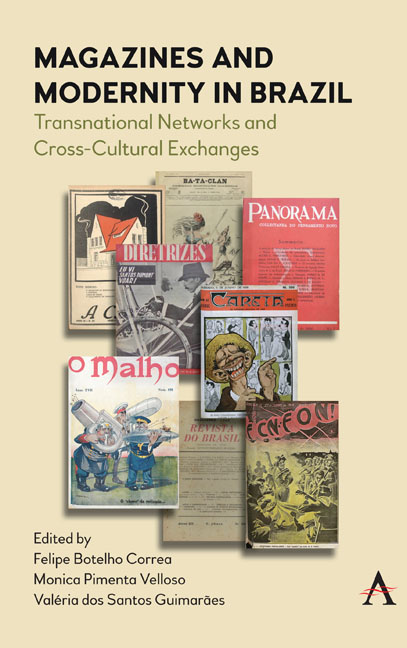Book contents
- Frontmatter
- Contents
- List of Figures
- List of Contributors
- Introduction
- Chapter 1 The French Periodical Print Culture In Brazil: A Survey of Catalogues and Mediators (1800–1945)
- Chapter 2 The Transnational Model of Popular Illustrated Magazines: Three Case Studies from Brazil (1900–20)
- Chapter 3 The Transnational Networks of the Modernist Periodical Print Culture: The Magazine Lumière in the Aftermath of WWI
- Chapter 4 Versions of Modernity in the Household Magazine A Casa (1923– 45)
- Chapter 5 Panorama Magazine and the Far-Right in Brazil (1936–37)
- Chapter 6 Against Nazi-Fascism in Brazil: The Case of the Magazine Diretrizes (1938–44)
- Chapter 7 Literary Inquiries and Disputes on Global Modernism: the Debate in Brazil During WWII
- Chapter 8 Modernity and Modernisms in the Magazine Sombra (1940–60)
- Index
Chapter 3 - The Transnational Networks of the Modernist Periodical Print Culture: The Magazine Lumière in the Aftermath of WWI
Published online by Cambridge University Press: 04 February 2022
- Frontmatter
- Contents
- List of Figures
- List of Contributors
- Introduction
- Chapter 1 The French Periodical Print Culture In Brazil: A Survey of Catalogues and Mediators (1800–1945)
- Chapter 2 The Transnational Model of Popular Illustrated Magazines: Three Case Studies from Brazil (1900–20)
- Chapter 3 The Transnational Networks of the Modernist Periodical Print Culture: The Magazine Lumière in the Aftermath of WWI
- Chapter 4 Versions of Modernity in the Household Magazine A Casa (1923– 45)
- Chapter 5 Panorama Magazine and the Far-Right in Brazil (1936–37)
- Chapter 6 Against Nazi-Fascism in Brazil: The Case of the Magazine Diretrizes (1938–44)
- Chapter 7 Literary Inquiries and Disputes on Global Modernism: the Debate in Brazil During WWII
- Chapter 8 Modernity and Modernisms in the Magazine Sombra (1940–60)
- Index
Summary
One of the many consequences of the fast development of communications throughout the nineteenth century was that, by the turn of the century, the press had not only become part of the everyday life of millions of people but also a strategic instrument in shaping the cultural debate. This was particularly evident in the context of magazine publishing, which was marked by an increasing segmentation as well as the proliferation of vanguard experimental publications specialized in art and literature, which became known as modernist magazines.
A trait that distinguished these modernist magazines from other publications was their clear drive to have an impact and intervene in society with ideas that were considered new. Some of these publications presented themselves as manifestos, making use of modern textual and pictorial tools that called for new aesthetics that could connect with the changes happening in society. By being bold and proposing concrete cultural agendas, many of these magazines sought to ensure their participation in national projects. However, many of these magazines were also part of transnational networks, often acting as a link between vanguards from various parts of the world and creating a complex circuit of influences and cross-cultural exchanges.
There is little controversy about the importance of the visual and editorial innovations of these publications to the development of modernism. However, the importance and details of their intellectual networks is still an area to be explored, particularly in contexts beyond the Western world. Directed by young intellectuals and artists, such publications often managed to create their own publishing companies through which they debated ideas, discussed projects, supported peers, organized art exhibitions and supported cultural events that helped to create connections between similar publications. At the beginning of the twentieth century, magazines such as Mercure de France, La Revue Blanche and La Plume stood out as models, followed by other literary publications such as the English Rhythm (1911) – later renamed as The Blue Review (1913) – focused mostly on the London–Paris literary axis, accelerating the exchange of ideas among the British, French and, to some extent, German networks. Nevertheless, the question of modernism in Europe went far beyond these contexts, with some interesting examples that fostered global transnational networks.
- Type
- Chapter
- Information
- Magazines and Modernity in BrazilTransnational Networks and Cross-Cultural Exchanges, pp. 57 - 76Publisher: Anthem PressPrint publication year: 2020



